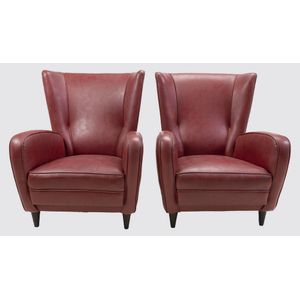Italian Art Deco Wingback Armchairs in Red Leatherette
A pair of Italian Art Deco armchairs, in the Gio Ponti style, circa 1940s, of wingback design, upholstered in red leatherette, raised on ebonised legs, 90 cm high
You must be a subscriber, and be logged in to view price and dealer details.
Subscribe Now to view actual auction price for this item
When you subscribe, you have the option of setting the currency in which to display prices to $Au, $US, $NZ or Stg.
This item has been sold, and the description, image and price are for reference purposes only.
- Art Deco Period - The Art Deco period was a cultural movement that emerged in the 1920s and 1930s, and was characterized by its emphasis on modernism, luxury, and elegance. The name "Art Deco" comes from the Exposition Internationale des Arts Décoratifs et Industriels Modernes, a large exhibition held in Paris in 1925 that showcased the latest trends in decorative arts.
Art Deco was a reaction against the ornate and elaborate styles of the previous era, and reflected a new modern sensibility. It was characterized by streamlined, geometric shapes, bright colours, and the use of new materials such as chrome, glass, and Bakelite. Art Deco designers sought to create a sense of luxury and sophistication, often incorporating expensive materials such as ivory, marble, and rare woods.
Art Deco had a significant impact on a wide range of artistic fields, including architecture, fashion, graphic design, and interior design. Some of the most iconic examples of Art Deco architecture include the Empire State Building in New York City, the Hoover Building in London, and the Palais de Chaillot in Paris.
The Art Deco period came to an end in the 1940s, as World War II and changing cultural trends led to a shift in artistic styles. However, Art Deco remains an important influence on design and art, and continues to be celebrated for its modernist sensibility and glamorous aesthetic. - Ebonised - Timber that has been stained or lacquered black in imitation of ebony. The process has been used since the Renaissance, but is most commonly found in late 19th century furniture, sometimes gilded and turned in imitation of bamboo. Furniture with an ebonised finish is not currently in vogue, and this is reflected in the price for such pieces.
- Circa - A Latin term meaning 'about', often used in the antique trade to give an approximate date for the piece, usually considered to be five years on either side of the circa year. Thus, circa 1900 means the piece was made about 1900, probably between 1895 and 1905. The expression is sometimes abbreviated to c.1900.
This item has been included into following indexes:
-
chairs, singles / pairs / threes, style or period
- armchairs 1,769
- Art Deco style 70
- ebonised 100
- Italian 98
- wing back chairs 124
Visually similar items

A Japanese Ando cloisonne vase, Showa period, circa 1930. On a pale yellow ground. 21.5 cm high
Sold by
in
for
You can display prices in $Au, $US, $NZ or Stg.

Sold by
in
for
You can display prices in $Au, $US, $NZ or Stg.

An Australian Sargisons silver Hobart spoon 21 grms
Sold by
in
for
You can display prices in $Au, $US, $NZ or Stg.

Petite antique sterling silver 8 day table clock, hallmarked Birmingham 1911, inscribed Muriel, with original key, 9 cm high
Sold by
in
for
You can display prices in $Au, $US, $NZ or Stg.
